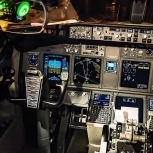
-
Content Count
2,364 -
Donations
$0.00 -
Joined
-
Last visited
Community Reputation
102 ExcellentAbout Spin737
-
Rank
Member - 2,000+
Profile Information
-
Gender
Male
Flight Sim Profile
-
Commercial Member
No
-
Online Flight Organization Membership
IVAO
-
Virtual Airlines
No
Recent Profile Visitors
4,993 profile views
-

Convert TAS cruise speed to Mach number for the FMC?
Spin737 replied to teopereira's topic in PMDG 737NGX | 737NGXu
Probably no need to run a converter. Just look at the TAS and if it's off, change your MACH speed in the MCP or CRZ page until it matches your desired TAS. Or you could change your CI to increase or decrease your TAS. That's not a constant, however. -

PMDG 737 MCP in Descent Mode Question
Spin737 replied to kaluleomorir's topic in PMDG 737NGX | 737NGXu
ALT INT is the correct method. Or a good method. If you're below path, the jet will descend at 1000fpm. If that's not quick enough for ATC, then you could SPD INT or use LVL CHG or VS. -

Simulation of autothrust when only operating with one engine
Spin737 replied to 737Andi's topic in PMDG 737NGX | 737NGXu
Single engine ops do no use auto-throttle in the 737. Blame Southwest. -

PMDG 737 NGX Pressurization Warning - Helios Airways Flight 522
Spin737 replied to CajunRon's topic in PMDG 737NGX | 737NGXu
word not allowed design. But put the mask on if you hear the horn and you're not taking off or landing. We have verbal alerts that tell us if we're on a runway, going too slow or forget to set the altimeter. But they couldn't put a verbal alert in the box. And forget an EICAS. -
Second click a second later on the same button you clicked the first time should work.
-
There's probably not a quick way to do it. You could go to POS and grab that and then make a temp nav point out of that. What's your plan for using that info?
-
You can set the clock on the plane to UTC from the GPS or you can select a MAN (manual) input.
-
Other countries don't necessarily mirror US regs. I've done +300 below 10k due to emergencies - Captain's Emergency Authority trumps 91.117.
-
You're really starting to split hairs. High speed climbs can be more efficient. Should you do that at CLB or CLB-1 or CLB-2? CLB-2 reduces engine wear, but increases fuel cost. Related anecdote: I flew in Korea for a bit. A local captain was so sure that hi-speed climbs were saving his company a ton of money and that American ATC should allow it, too. I didn't tell him that any money he saved on the climb was eaten by only performing full approaches everywhere instead of a nice, short visual approach.
-

Simulating the 900ER / Derated Takeoffs
Spin737 replied to Matt2218's topic in PMDG 737NGX | 737NGXu
No weight limit. Flaps 40 in gusty conditions is usually a bad idea - especially in a straight -900 as they are even closer to a blowback. I was flying a -900 last fall and the FO kept getting close to the flap limit and I was calling his speeds so we didn't exceed the limit. He got the plane on the ground, nice landing. No exceedences. Next leg is mine. Of course on that leg, I'm the one who gets the blowback. Sigh. -

Aircraft too high on a VNAV descent
Spin737 replied to Ray Proudfoot's topic in PMDG 737NGX | 737NGXu
Just to clarify a few things: This issue was caused by enginges not being at idle. LVL CHG (not FLCH or FL CHG) will not magically increase your descent performance. It may, however, cause you a violation for busting an altitude restriction that VNAV would have honored. Don't use the bar to disengage the autopilot. -
The day the -400 leaves is the day you'll get manuals for the MAX. 😉
-

737 descend before reaching T/D and mid-flight
Spin737 replied to LeifApex's topic in PMDG 737NGX | 737NGXu
I think it was a joke. Hence the laugh emoji. -
Generally, for changes of less than 1000’, use V/S or VNAV. LVL CHG takes a bit to get pitched over and is a bit abrupt in a short altitude change.
-
I don't think there's any difference - the engines will still go to CLB N1 at VNAV SPD or MCP SPD, which would probably be the same. V/S is smoother if you limit the ROC.








